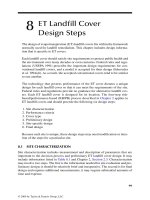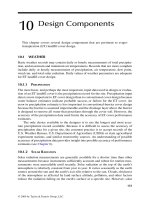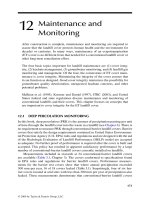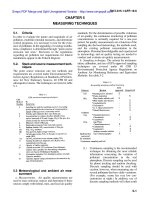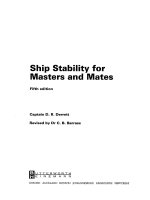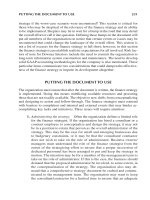Ship Stability for Masters and Mates 5 Episode 10 pot
Bạn đang xem bản rút gọn của tài liệu. Xem và tải ngay bản đầy đủ của tài liệu tại đây (1.16 MB, 35 trang )
304 Ship Stability for Masters and Mates
Fig. 35.1. Deadweight Scale
Chapter 36
Interaction
What exactly is interaction?
Interaction occurs when a ship comes too close to another ship or too close
to, say, a river or canal bank. As ships have increased in size (especially in
Breadth Moulded), Interaction has become very important to consider. In
February 1998, the Marine Safety Agency (MSA) issued a Marine Guidance
note `Dangers of Interaction', alerting Owners, Masters, Pilots, and Tug-
Masters on this topic.
Interaction can result in one or more of the following characteristics:
1 If two ships are on a passing or overtaking situation in a river the squats
of both vessels could be doubled when their amidships are directly in
line.
2 When they are directly in line each ship will develop an angle of heel and
the smaller ship will be drawn bodily towards the larger vessel.
3 Both ships could lose steerage ef®ciency and alter course without change
in rudder helm.
4 The smaller ship may suddenly veer off course and head into the adjacent
river bank.
5 The smaller ship could veer into the side of the larger ship or worse still
be drawn across the bows of the larger vessel, bowled over and capsized.
In other words there is:
(a) a ship to ground interaction;
(b) a ship to ship interaction;
(c) a ship to shore interaction.
What causes these effects of interaction? The answer lies in the pressure
bulbs that exist around the hull form of a moving ship model or a moving
ship. See Figure 36.1. As soon as a vessel moves from rest, hydrodynamics
produce the shown positive and negative pressure bulbs. For ships with
greater parallel body such as tankers these negative bulbs will be
comparatively longer in length. When a ship is stationary in water of zero
current speed these bulbs disappear.
Note the elliptical Domain that encloses the vessel and these pressure
bulbs. This Domain is very important. When the Domain of one vessel
interfaces with the Domain of another vessel then interactio n effects will
occur. Effects of interaction are increased when ships are operating in
shallow waters.
Ship to ground (squat) interaction
In a report on measured ship squats in the St Lawrence seaway, A. D. Watt
stated: `meeting and passing in a channel also has an effect on squat. It was
found that when two ships were moving at the low speed of ®ve knots that
squat increased up to double the normal value. At higher speeds the squat
when passing was in the region of one and a half times the normal value.'
Unfortunately, no data relating to ship types, gaps between ships, blockage
factors etc. accompanied this statement.
Thus, at speeds of the order of ®ve knots the squat increase is 100 per
cent whilst at higher speeds, say ten knots, this increase is 50 per cent.
Figure 36.2 illustrates this passing manoeuvre. Figure 36.3 interprets the
percentages given in the previous paragraph.
How may these squat increases be explained? It has been shown in the
chapter on Ship Squat that its value depends on the ratio of the ship's cross-
section to the cross-section of the river. This is the blockage factor `S'. The
presence of a second ship meeting and crossing will of course increase the
blockage factor. Consequently the squat on each ship will increase.
Maximum squat is calculated by using the equation:
d
max
C
b
 S
0X81
 V
2X08
k
20
metres
Consider the following example.
306 Ship Stability for Masters and Mates
Fig. 36.1. Pressure distribution around ship's hull (not drawn to scale).
Interaction 307
Fig. 36.2. Amidships (
e
) of VLCC directly in line with amidships of OBO ship in
St Lawrence seaway.
Fig. 36.3. Maximum squats for one ship, and for the same ship with another ship
present.
Example 1
A supertanker has a breadth of 50 m with a static even-keel draft of 12.75 m.
She is proceeding along a river of 250 m and 16 m depth rectangular cross-
section. If her speed is 5 kts and her C
B
is 0.825, calculate her maximum squat
when she is on the centre line of this river.
S
b  T
B ÂH
50 Â 12X75
250 Â 16
0X159
d
max
0X825 Â 0X159
0X81
 5
2X08
20
0X26 m
Example 2
Assume now that this supertanker meets an oncoming container ship also
travelling at 5 kts. See Figure 36.4. If this container ship has a breadth of 32 m a
C
b
of 0.580, and a static even-keel draft of 11.58 m calculate the maximum
squats of both vessels when they are transversely in line as shown.
S
b
1
 T
1
b
2
 T
2
B Â H
S
50 Â 12X7532 Â11X58
250 Â 16
0X252
Supertanker:
d
max
0X825 Â 0X252
0X81
 5
2X08
20
0X38 m at the bow
Container ship:
d
max
0X580 Â 0X252
0X81
 5
2X08
20
0X27 m at the stern
The maximum squat of 0.38 m for the supertanker will be at the bow because
her C
b
is greater than 0.700. Maximum squat for the container ship will be at
the stern, because her C
b
is less than 0.700. As shown this will be 0.27 m.
If this container ship had travelled alone on the centre line of the river then
her maximum squat at the stern would have only been 0.12 m. Thus the
presence of the other vessel has more than doubled her squat.
Clearly, these results show that the presence of a second ship does increase
ship squat. Passing a moored vessel would also make blockage effect and squat
greater. These values are not qualitative but only illustrative of this phenom-
enon of interaction in a ship to ground (squat) situation. Nevertheless, they are
supportive of A. D. Watt's statement.
Ship to ship Interaction
Consider Figure 36.5 where a tug is overtaking a large ship in a narrow
river. Three cases have been considered:
308 Ship Stability for Masters and Mates
Interaction 309
Fig. 36.4. Transverse squat caused by ships crossing in a con®ned channel.
L
c
L
c
Fig. 36.5. Ship to ship interaction in a narrow river during an overtaking manoeuvre.
Case 1. The tug has just come up to aft port quarter of the ship. The
Domains have become in contact. Interaction occurs. The positive bulb of
the ship reacts with the positive bulb of the tug. Both vessels veer to port
side. Rate of turn is greater on the tug. There is a possibility of the tug
veering off into the adjacent river bank as shown in Figure 36.5.
Case 2. The tug is in danger of being drawn bodily towards the ship
because the negative pressure (suction) bulbs have interfaced. The bigger
the differences between the two deadweights of these ships the greater will
be this transverse attraction. Each ship develops an angle of heel as shown.
There is a danger of the ship losing a bilge keel or indeed fracture of the
bilge strakes occurring. This is `transverse squat', the loss of underkeel
clearance at forward speed. Figure 36.4 shows this happening with the
tanker and the container ship.
Case 3. The tug is positioned at the ship's forward port quarter. The
Domains have become in contact via the positive pressure bulbs. Both
vessels veer to the starboard side. Rate of turn is greater on the tug. There
is great danger of the tug being drawn across the path of the ship's heading
and bowled over. This has actually occurred with resulting loss of life.
Note how in these three cases that it is the smaller vessel, be it a tug, a
pleasure craft or a local ferry involved, that ends up being the casualty!!
Figures 36.6 and 36.7 give further examples of ship to ship Interaction
effects in a river.
Methods for reducing the effects of Interaction in Cases 1 to 5
Reduce speed of both ships and then if safe increase speeds after the
meeting crossing manoeuvre time slot has passed. Resist the temptation to
go for the order `increase revs' This is because the forces involved with
Interaction vary as the speed squared. However, too much a reduction in
speed produces a loss of steerage because rudder effectiveness is decreased.
This is even more so in shallow waters, where the propeller rpm decrease
for similar input of deep water power. Care and vigilance are required.
Keep the distance between the vessels as large as practicable bearing in
mind the remaining gaps between each ship side and nearby river bank.
Keep the vessels from entering another ship's Domain, for example
crossing in wider parts of the river.
Cross in deeper parts of the river rather than in shallow waters, bearing in
mind those increases in squat.
Make use of rudder helm. In Case 1, starboard rudder helm could be
requested to counteract loss of steerage. In Case 3, port rudder helm would
conteract loss of steerage.
Ship to shore interaction
Figures 36.8 and 36.9 show the ship to shore Interaction effects. Figure 36.8
shows the forward positive pressure bulb being used as a pivot to bring a
ship alongside a river bank.
Interaction 311
Fig. 36.6. Case 4. Ship to ship interaction. Both sterns swing towards river banks. The approach situation.
Fig. 36.7. Case 5. Ship to ship interaction. Both bows swing towards river banks. The leaving situation.
Figure 36.9 shows how the positive and negative pressure bulbs have
caused the ship to come alongside and then to veer away from the jetty.
Interaction could in this case cause the stern to swing and collide with the
wall of this jetty.
Summary
An understanding of the phenomenon of Interaction can avert a possible
marine accident. Generally a reduction in speed is the best preventive
procedure. This could prevent on incident leading to loss of sea worthiness,
loss of income for the shipowner, cost of repairs, compensation claims and
maybe loss of life.
Interaction 313
Fig. 36.8. Ship to bank interaction. Ship approaches slowly and pivots on for-
ward positive pressure bulb.
Fig. 36.9. Ship to bank interaction. Ship comes in at too fast a speed. Interaction
causes stern to swing towards river bank and then hits it.
314 Ship Stability for Masters and Mates
Exercise 36
1 A river is 150 m wide and has 12 m depth of water. A passenger liner
having a breadth of 30 m a static even-keel draft of 10 m and a C
b
of 0.625
is proceeding along this river at 8 kts. She meets an approaching general
cargo vessel having a breadth of 20 m, a static even-keel draft of 8 m and a
C
b
of 0.700 moving at 7 kts.
Estimate the maximum squats of each vessel when their amidships are
transversely in line.
2 With the aid of sketches, de®ne Interaction and list how its effects may be
limited. Show clearly how Interaction and transverse squat are inter-related.
Chapter 37
Effect of change of
density on draft
and trim
When a ship passes from water of one density to water of another density
the mean draft is changed and if the ship is heavily trimmed, the change in
the position of the centre of buoyancy will cause the trim to change.
Let the ship in Figure 37.1 ¯oat in salt water at the waterline WL. B
represents the position of the centre of buoyancy and G the centre of
gravity. For equilibrium, B and G must lie in the same vertical line.
If the ship now passes into fresh water, the mean draft will increase. Let
W
1
L
1
represent the new waterline and b the centre of gravity of the extra
volume of the water displaced. The centre of buoyancy of the ship, being
the centre of gravity of the displaced water, will move from B to B
1
in a
direction directly towards b. The force of buoyancy now acts vertically
upwards through B
1
and the ship's weight acts vertically downwards
through G, giving a trimming moment equal to the product of the
displacement and the longitudinal distance between the centres of gravity
and buoyancy. The ship will then change trim to bring the centres of
gravity and buoyancy back in to the same vertical line.
Example
A box-shaped pontoon is 36 m long, 4 m wide and ¯oats in salt water at drafts
F 2.00 m. A 4.00 m. Find the new drafts if the pontoon now passes into fresh
Fig. 37.1
water. Assume salt water density is 1.025 t/m
3
. Assume fresh water
density 1.000 t/m
3
.
(a) To Find the Position of B
1
BB
1
v Âgg
1
V
v
1
2
 1 Â
36
2
 4
36 cu. m
gg
1
2
3
 36
gg
1
24 m
V 36 Â 4 Â3
432 cu. m
; BB
1
36 Â24
432
2m
Because the angle of trim is small, BB
1
is considered to be the horizontal
component of the shift of the centre of buoyancy.
Now let the pontoon enter fresh water, i.e. from r
SW
into r
FW
. Pontoon will
develop mean bodily sinkage.
(b) To Find the New Draft
In Salt Water
Mass Volume  Density
36 Â 4 Â 3 Â1X025
In Fresh Wate r.
Mass Volume  Density
; Volume
Mass
Density
36 Â4 Â3 Â 1X025
1X000
cu. m
(Mass in Salt water Mass in Fresh Water)
316 Ship Stability for Masters and Mates
Fig. 37.2
Let
MBS Mean Bodily Sinkage &
SW
higher densityY&
FW
lower density
MBS
W
TPC
SW
Â
r
SW
À r
FW
r
FW
MBS
LCBCdr
SW
LC Â BC
100
 r
SW
r
SW
À r
FW
r
FW
&'
; MBS
dr
SW
À r
FW
r
FW
 100
MBS
3 Â0X025
1X000
 100
0X075 m
; MBS 0X075 m
Original mean draft 3X000 m
New mean draft 3X075 m say draft d
2
(c) Find the Change of Trim
Let B
1
B
2
be the horizontal component of the shift of the centre of buoyancy.
Then
B
1
B
2
v Âd
V
10X8 Â2
442X8
; B
1
B
2
0X0487 m
W LBd
SW
 r
SW
36 Â 4 Â 3 Â1X025
; W 442X8 tonnes
Trimming Moment W Â B
1
B
2
36 Â 4 Â 3 Â
1X025
1X000
t Â0X0487 m 21X56 t m
BM
L2
L
2
12d
2
36
2
12 Â3X075
36
1X025
m 35X12 m
MCTC 9
W ÂBM
L
100 Â L
442X8 Â 35X12
100 Â 36
4X32 tonnes metres
Change of Trim
Trimming Moment
MCTC
21X56
4X32
5cm
Effect of change of density on draft and trim 317
Change of Trim 5 cm by the stern
0X05 m by the stern
Drafts before Trimming A 4.075 m F 2.075 m
Change due to trim 0X025 m À0X025 m
New Drafts A 4.100 m F 2.050 m
In practice the trimming effects are so small that they are often ignored by
shipboard personnel. Note in the above example the trim ratio forward and aft
was only 2
1
2
cm.
However, for D.Tp. examinations, they must be studied and fully under-
stood.
318 Ship Stability for Masters and Mates
Exercise 37
1 A box-shaped vessel is 72 m long, 8 m wide and ¯oats in salt water at drafts
F 4.00 m. A 8.00 m. Find the new drafts if the vessel now passes into fresh
water.
2 A box-shaped vessel is 36 m long, 5 m wide and ¯oats in fresh water at
drafts F 2.50 m. A 4.50 m. Find the new drafts if the vessel now passes into
salt water.
3 A ship has a displacement of 9100 tonnes, LBP of 120 m, even-keel draft of
7 m in fresh water of density of 1.000 t/m
3
.
From her Hydrostatic Curves it was found that:
MCTC
SW
is 130 t m/cm
TPC
SW
is 17.3 t
LCB is 2 m forward
e
and
LCF is 1.0 aft
e
X
Calculate the new end drafts when this vessel moves into water having a
density of 1.02 t/m
3
without any change in the ship's displacement of 9100
tonnes.
Chapter 38
List with zero
metacentric height
When a weight is shifted transversely in a ship with zero initial metacentric
height, the resulting list can be found using the `Wall sided' formula.
The ship shown in Figure 38.1 ha s zero initial metacentric height. When a
weight of mass `w' is shifted transversely through a distance `d', the ship's
centre of gravity shifts from G to G
1
where the direction GG
1
is parallel to
the shift of the centre of gravity of the weight shifted. The ship will then
incline to bring the centres of gravity and buoyancy in the same vertical
line.
The horizontal component of the shift of the ship's centre of gravity is
equal to GZ and the horizontal component of the shift of the centre of
Fig. 38.1
gravity of the weight is equal to d cos y.
; w ÂdEcos y W ÂGZ
The length GZ, although not a righting lever in this case can be found
using the `Wall-sided' formula.
i.e.
GZ GM
1
2
EBMEtan
2
ysin y
; w  dEcos y WEsin y GM
1
2
EBMEtan
2
y
If
GM 0
Then
w  dEcos y WEsin yE
1
2
BMEtan
2
y
w  d
W
sin y
cos y
E
1
2
EBMEtan
2
y
2EwEd
BMEW
tan
3
y
or
tan y
2EwEd
BMEW
3
r
Example
A ship of 12 250 tonnes displacement, has KM 8m, KB 3.8 m, KG 8m
and is ¯oating upright. Find the list if a weight of 2 tonnes, already on board, is
shifted transversely through a horizontal distance of 12 m, assuming that the
ship is wall-sided.
KM 8X0m
À
KB 3X8m
BM 4X2m
The ship has zero GM
; tan list
2EwEd
WEBM
3
r
tan list
2E2E12
12 250 Â 4X2
3
r
0X0977
Ans.
List 5
34
H
320 Ship Stability for Masters and Mates
List with zero metacentric height 321
Exercise 38
1 Find the list when a mass of 10 tonnes is shifted transversely through a
horizontal distance of 14 m in a ship of 8000 tonnes displacement which
has zero initial metacentric height. BM 2m.
2 A ship of 8000 tonnes displacement has zero initial metacentric height.
BM 4 m. Find the list if a weight of 20 tonnes is shifted transversely
across the deck through a horizontal distance of 10 m.
3 A ship of 10 000 tonnes displacement is ¯oating in water of density
1.025 kg/cu. m and has a zero initial metacentric height. Calculate the list
when a mass of 15 tonnes is moved transversely across the deck through a
horizontal distance of 18 m. The second moment of the waterplane area
about the centre line is 10
5
m
4
X
4 A ship of 12 250 tonnes displacement is ¯oating upright. KB 3.8 m,
KM 8 m and KG 8 m. Assuming that the ship is wall-sided, ®nd the list
if a mass of 2 tonnes, already on board, is shifted transversely through a
horizontal distance of 12 m.
Chapter 39
The Trim and Stability
book
When a new ship is nearing completion, a Trim and Stability boo k is
produced by the shipbuilder and presented to the shipowner. Shipboard
of®cers will use this for the day to day operation of the vessel. In the Trim
and Stability book is the following technical data:
1 General particulars of the ship.
2 Inclining experiment report and its results.
3 Capacity, VCG, LCG particulars for all holds, compartments, tanks etc.
4 Cross curves of stability. These may be GZ curv es or KN curves.
5 Deadweight scale data. May be in diagram form or in tabular form.
6 Hydrostatic curves. May be in graphical form or in tabular form.
7 Example conditions of loading such as:
Lightweight (empty vessel) condition.
Full-loaded Departure and Arrival conditions.
Heavy-ballast Departure and Arrival conditions.
Medium-ballast Departure and Arrival conditions.
Light-ballast Departure and Arrival conditions.
On each condition of loading there is a pro®le and plan view (at upper
deck level usually). A colour scheme is adopted for each item of
deadweight. Examples could be red for cargo, blue for fresh water,
green for water ballast, brown for oil. Hatched lines for this Dwt
distribution signify wing tanks P and S.
For each loaded condition, in the interests of safety, it is necessary to
show:
Deadweight.
End draughts, thereby signifying a satisfactory and safe trim situation.
KG with no Free Surface Effects (FSE), and KG with FSE taken into
account.
Final transverse metacentric height (GM). This informs the of®cer if the
ship is in stable, unstable or neutral equilibrium. It can also indicate if
the ship's stability is approaching a dangerous state.
Total Free Surface Effects of all slack tanks in this condition of
loading.
A statical stability curve relevant to the actual loaded condition with the
important characteristics clearly indicated. For each S/S curve it is
important to observe the following:
Maximum GZ and the angle of heel at which it occurs.
Range of stability.
Area enclosed from zero degrees to thirty degrees (A1) and the area
enclosed from thirty degrees to forty degrees (A2) as shown in Figure
39.1.
Shear force and bending moment curves, with upper limit lines clearly
superimposed as shown in Figure 39.2.
8 Metric equivalents. For example, TPI
HH
to TPC, MCTI
HH
to MCTC, or
tons to tonnes.
All of this information is sent to a D.Tp. surveyor for appraisal. On many
ships today this data is part of a computer package. The deadweight items
are keyed in by the of®cer prior to any weights actually being moved. The
computer screen will then indicate if the prescribed condition of loading is
indeed safe from the point of view of stability and strength.
The Trim and Stability book 323
Fig. 39.1. Enclosed areas on a statical stability curve.
324 Ship Stability for Masters and Mates
Fig. 39.2. SF and BM curves with upper limit lines.
Chapter 40
Bending of beams
Beam theory
The bending of ships can be likened to the bending of beams in many cases.
This chapter shows the procedures employed with beam theory.
The problem of calculating the necessary strength of ships is made
dif®cult by the many and varied forces to which the ship structure is
subjected during its lifetime. These forces may be divided into two groups,
namely statical forces and dynamical forces.
The statical forces are due to:
1 The weight of the structure which varies throughout the length of the
ship.
2 Buoyancy forces, which vary over each unit length of the ship and are
constantly varying in a seaway.
3 Direct hydrostatic pressure.
4 Concentrated local weights such as machinery, masts, derricks, winches,
etc.
The dynamical forces are due to:
1 Pitching, heaving and rolling,
2 Wind and waves.
These forces cause bending in several planes and local strains are set up
due to concentrated loads. The effects are aggravated by structural
discontinuities.
The purpose of the present chapter is to consider the cause of longi-
tudinal bending and its effect upon structures.
Stresses
A stress is the mutual actual between the parts of a material to preserve
their relative positions when external loads are applied to the material.
Thus, whenever external loads are applied to a material stresses are created
within the material.
Tensile and compressive stresses
When an external load is applied to a material in such a way as to cause an
extension of the material it is called a `tensile' load, whilst an external load
tending to cause compression of the material is a `compressi ve' load.
Figure 40.1 shows a piece of solid material of cylindrical section to which
an external load W is applied. In the ®rst case the load tends to cause an
extension of the material and is therefore a tensile load. The applied load
creates stresses within the material and these stresses are called `tensile'
stresses. In the second case the load applied is one of compression and the
consequent stresses within the material are called `compressive' stresses.
When a tensile or compressive external load is applied to a material the
material will remain in equilibrium only so long as the internal forces can
resist the stresses created.
Shearing stresses
A shearing stress is a stress within a material which tends to break or shear
the material across.
Figure 40.2(a) and 40.2(b) illustrate shearing stresses which act normally
to the axis of the material.
In the following text when the direction of a shearing stress is such that
326 Ship Stability for Masters and Mates
Fig. 40.1
the section on the right-hand side of the material tends to move down-
wards, as shown in Figure 40.2(a), the stress is considered to be positive,
and when the direction of a stress is such that the section on the right-hand
side tends to move upwards as shown in Figure 40.2(b), the shearing stress
is considered to be negative.
Bending of beams 327
Fig. 40.2
Shearing stresses are resisted by the material but shearing will take place
when the shear stress reaches the ultimate shear stress of the material.
Complementary stress
It has already been stated that when a direct load is applied to a material
stresses are created within the material and that the material will remain in
equilibrium only so long as the internal forces can resist the stresses created.
Let the bar in Figure 40.3(a) be subjected to tensile load W and imagine
the bar to be divided into two parts at section AB.
For equilibrium, the force W on the left-hand side of the bar is balanced
by an equal force acting to the right at section AB. The balancing force is
supplied by the individual molecular forces which represent the action of
the molecules on the right-hand side of the section on those of the left-hand
section. Similarly, the force W on the right-hand side of the bar is balanced
by the individual molecular forces to the left of the section. Therefore, when
an external load W is applied to the bar, at any section normal to the axis of
the bar, there are equal and opposite internal forces acting, each of which
balances the external force W. The magnitude of the internal forces per unit
area of cross-section is called the stress. When the section is well removed
from the point of application of the external load then the stress may be
considered constant at all parts of the section and may be found by the
formula:
Stress (f)
Load (W)
Area (A)
; f
W
A
Let us now consider the stresses created by the external load W in a
section which is inclined to the axis of the bar. For example, let section CD
in Figure 40.3(b) be inclined at an angle y to the normal to the axis of the
bar and let the section be suf®ciently removed from the point of application
of the load to give uniform stress across the section.
The load transmitted by the section CD, for equilibrium, is equal to the
external force W. This load can be resolved into two components, one of
which is WEcos y and acts normal to the section, and the other is WEsin y
and acts tangential to the section. This shows that for direct tensile or
compressive loading of the bar stresses other than normal stresses may be
created.
Now let us consider the small block of material abcd in the section on the
left-hand side of the plane, as shown in Figure 40.3(c). Let the face ab be
coincident with the plane CD and let F
N
be the internal force normal to this
face and F
T
the internal force tangential to the face. For the block to be in
equilibrium the left-hand side of the section must provide two stresses on
the face cd. These are F
N
and F
T
. Thus the stress F
N
normal to the face ab is
balanced by the stress F
N
normal to the face cd whilst the two tangential
stresses (F
T
) on these faces tend to produce clockwise rotation in the block.
Rotation can only be prevented if an equal and opposite couple is produced
328 Ship Stability for Masters and Mates

![ship stability for masters and mates [electronic resource]](https://media.store123doc.com/images/document/14/y/bj/medium_bjc1401370968.jpg)

